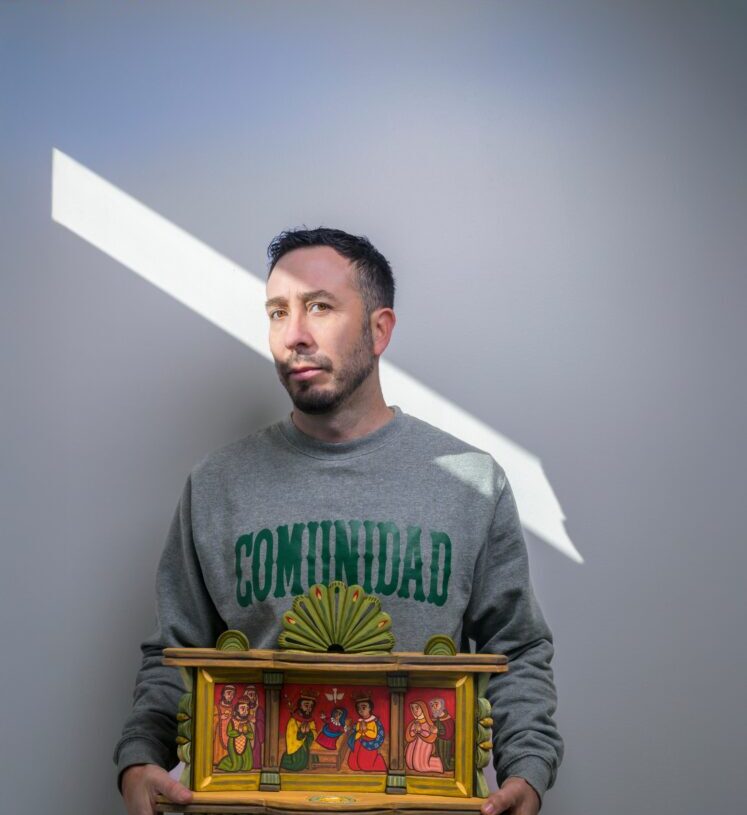After 20 years as an artist, Vicente Telles hung one of his paintings in a Smithsonian museum for the first time this fall. The self-portrait shows a man draped in a quilt with an empty sack of government commodity pinto beans covering his face. Pigeons sit on his shoulder and lap, their heads also covered by commodity goods.
Telles said the artwork expresses how it feels to be stereotyped as a Latino man in the United States, where he has heard racial slurs aimed at taking away his humanity.
The Smithsonian picked Telles, along with 35 other up-and-coming artists, to display work in the National Portrait Gallery as part of the triennial open-call Outwin Boochever Portrait Competition. The top prize winner gets $25,000 and is commissioned to create a piece for the museum’s permanent collection.
But just days before the exhibit was set to open in October, all Smithsonian Institution facilities closed because of the federal government shutdown.
“It was a very, very big honor to represent my culture, my community, my area where I come from, but that’s not happening,” Telles said recently. “It’s an honor that can’t be taken away, but it’s an honor that I can’t [yet] share with my community.”
That will soon change. This week, more than a month after its planned opening date, the Smithsonian said The Outwin exhibit will debut Jan. 24.
In a statement, the Smithsonian called the exhibit a chance to support “the next wave of contemporary portraiture.” Despite a late opening, the statement said the exhibit will close as planned next August.
John Boochever, whose mother Virginia Outwin Boochever founded the competition, said he never doubted the exhibition would eventually open. The competition didn’t set out to be a diversity initiative, he said, but rather naturally brings together the different cultures in the U.S.
Many artists selected for the Outwin said their work explores family legacy, cultural identity or belonging. Ruth Dealy’s self portrait, titled “Becoming Aware,” embodies the idea of reemergence as a woman in a society riddled with sexism. Sandra Bacchi, a Brazilian immigrant, uses art to encapsulate how culture passes through generations. Steven Harwick pays homage to gay culture with art he calls queer, BDSM kink photography.
The latest iteration of the Outwin was originally set to open in May, but the Smithsonian pushed the date to help better accommodate submissions and to overlap with the museums’ celebration of the country’s 250th anniversary next year, according to an email obtained by The Washington Post.
Then came the 43-day shutdown, the longest in history.
As the artists wait to share their work with the world, some say it’s unfair that their careers had to reap the consequences of a political standoff. Others said they worry their entries might be removed from the show. They pointed to the decision of Amy Sherald to pull a solo exhibit from the National Portrait Gallery this summer over censorship concerns. Sherald rocketed to fame behind a 2018 portrait of Michelle Obama, which was commissioned after she won the 2016 Outwin competition.
Sherald said she pulled the solo show after the museum considered removing her painting that depicted a transgender Statue of Liberty. The Smithsonian said it wanted to add a video to contextualize the painting, not remove it. The exhibit is now on display at the Baltimore Museum of Art.
The Smithsonian said in a statement that it will not remove any artwork from the Outwin exhibit.
Still, some artists are worried. Before the October opening date, artists collaborated with show curators to write a short description to accompany their work. But the museum later decided to scrap them.
Stephanie Woods, who describes herself as a prop maker, said pulling the descriptions felt like a form of censorship. Her print, titled “my papa used to play checkers,” pays homage to African female rice farmers. The description she submitted to the museum said her work explores themes of identity and belonging within African diasporic traditions. It also touches on reclamation of watermelon as a fruit to celebrate freedom and the right to property after emancipation.
“It feels wrong to share work in a museum without context or description — silencing the artist’s voice in the process,” Woods said. “While I’m saddened by the delay, I find my energy now focused less on when I’ll get to share my work and more on how artistic freedom will evolve over the next three years.”
The Smithsonian said in a statement that each competition has varied slightly in presentation and this year’s labels are an “experimental approach” it will evaluate through visitor feedback.
Artist Stella Nall said she’s been on edge about the exhibition since before the shutdown but is glad to see it finally come to fruition. Based in Missoula, Montana, Nall has never been to the nation’s capital. She booked her accommodations for the October opening well in advance, but had to cancel at the last minute. Now, she’s gearing up again and keeping her fingers crossed.
Nall is a first descendant of the Apsáaloke, or Crow, Tribe, an identity she explores in her art. Nall has shown art in the National Museum of the American Indian, but the Outwin will be her first display in the Portrait Gallery.
“It feels like an especially important time to be sharing work as a native artist, and I’m really grateful to get to do that,” she said. “I’m going to continue doing that, regardless of whatever is happening politically.”
The post Their art hangs in the Smithsonian. It’s still waiting to be seen. appeared first on Washington Post.




